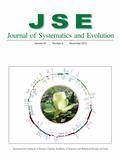Table of Contents
-

Volume 50 Issue 6
Cover illustration: The American lotus, Nelumbo lutea, is one of the two living fossils in family Nelumbonaceae. Although the family has diverged from its relatives for more than 100 million years, the chloroplast genome of N. lutea is of a typical structure of plants and the American lotus has just split from its Asian counterpart, N. nucifera, for a few million years. For detailed chloroplast genome of N. lutea and molecular dating of lotus family and other angiosperms, please see XUE et al., pp. 477–487 in this issue. Designed and illustrated by Shi-Liang ZHOU; photo at North Carolina, USA, by Hongli TIAN. [Detail] ...
Editors-in-Chief
Song Ge
Jun Wen
Song Ge
Jun Wen
Impact Factor
3.7
JCR 2022 IF ranking: 60/238 (Plant Sciences, top 25%, Q2 quartile)
Journal Abbreviation: J Syst Evol
CN: 11-5779/Q
Frequency: Bi-monthly
Journal Abbreviation: J Syst Evol
| ISSN: | 1674-4918 (Print) 1759-6831 (Online) |
Frequency: Bi-monthly

Scan to view the journal on your mobile
device
device

Scan to follow us on WeChat







